宾语补足语讲解
- 格式:doc
- 大小:39.00 KB
- 文档页数:3
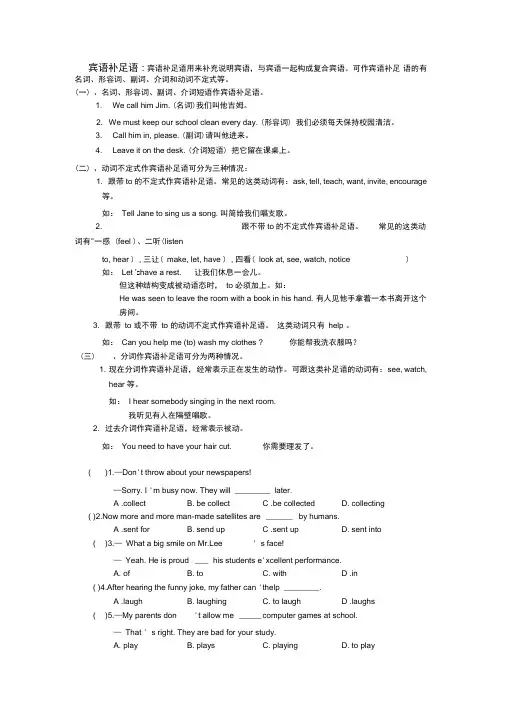
宾语补足语: 宾语补足语用来补充说明宾语,与宾语一起构成复合宾语。
可作宾语补足语的有名词、形容词、副词、介词和动词不定式等。
(一)、名词、形容词、副词、介词短语作宾语补足语。
1. We call him Jim. (名词)我们叫他吉姆。
2. We must keep our school clean every day. (形容词) 我们必须每天保持校园清洁。
3. Call him in, please. (副词)请叫他进来。
4. Leave it on the desk. (介词短语) 把它留在课桌上。
(二)、动词不定式作宾语补足语可分为三种情况:1. 跟带to 的不定式作宾语补足语。
常见的这类动词有:ask, tell, teach, want, invite, encourage等。
如:Tell Jane to sing us a song. 叫简给我们唱支歌。
2. 跟不带to的不定式作宾语补足语。
常见的这类动词有"一感 (feel )、二听(listento, hear ) , 三让( make, let, have ) , 四看( look at, see, watch, notice )如:Let 's have a rest. 让我们休息一会儿。
但这种结构变成被动语态时,to 必须加上。
如:He was seen to leave the room with a book in his hand. 有人见他手拿着一本书离开这个房间。
3. 跟带to 或不带to 的动词不定式作宾语补足语。
这类动词只有help 。
如:Can you help me (to) wash my clothes ? 你能帮我洗衣服吗?(三)、分词作宾语补足语可分为两种情况。
1. 现在分词作宾语补足语,经常表示正在发生的动作。
可跟这类补足语的动词有:see, watch,hear 等。
如:I hear somebody singing in the next room.我听见有人在隔壁唱歌。

非谓语动词作宾语补足语定义:宾语补足语通常是位于宾语之后,说明宾语的状态、特征的成分,多由名词,形容词、副词、不定式,动名词个分词充当.如:The sun keeps us warm.We call her Jenny.They found him out.Make yourself at home.They wish you to go with them.I heard him singing.You must get your hair cut.宾语+宾语补足语=复合宾语,宾语和宾语补足语之间在逻辑上往往有主表、或者主谓的关系.一、动词不定式作宾补。
1.V1 + sb. + to do sth.常用动词有:advise 建议allow 允许ask 叫,请bear 忍受beg 乞求cause 导致command 命令encourage 鼓励expect 期待forbid 禁止force 迫使get 使hate 讨厌help 帮助intend 想要invite 邀请leave 让like 喜欢mean 打算need 需要oblige 迫使order 命令permit 允许persuade 说服prefer 宁愿request 请求remind 提醒teach 教tell 告诉trouble 麻烦want 想要warn 警告wish 希望wait for 等would like 想要would love 想要would prefer 宁愿persuade (劝说)sb to do sth = persuade sb into doing sth温馨提示:1.advise, forbid,allow, permit 这四个词后既可以直接加动名词作宾语,也可以接不定式作宾语补足语,即构成doing sthadvise/ forbid/ allow/ permitsb to do sth2.fear, excuse, refuse, insist, hope, suggest, agree, decide, demand, thank, arrange 等动词后不可接sb to do sth。
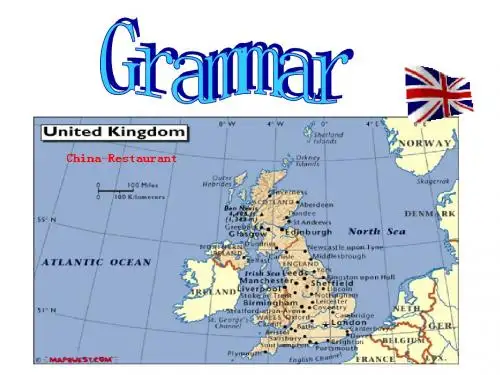
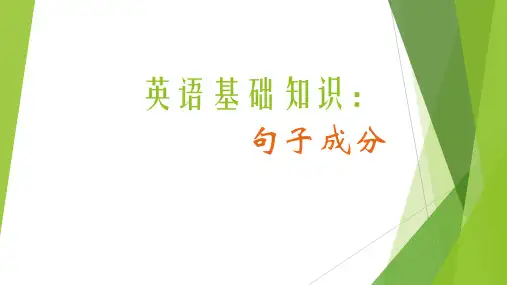
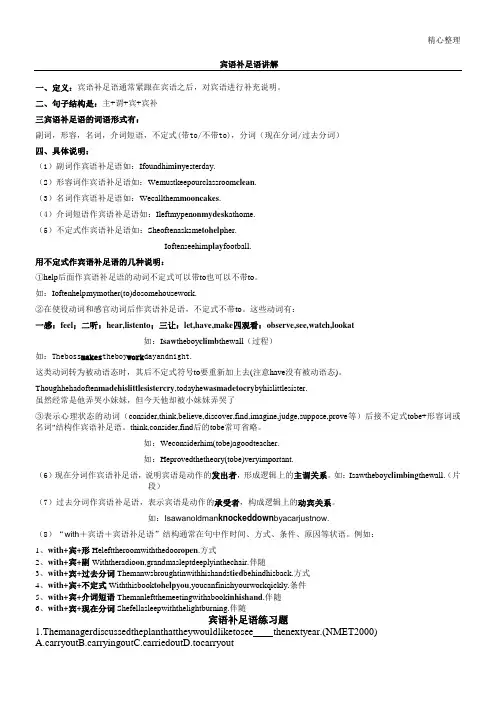
精心整理宾语补足语讲解一、定义:宾语补足语通常紧跟在宾语之后,对宾语进行补充说明。
二、句子结构是:主+谓+宾+宾补三宾语补足语的词语形式有:副词,形容,名词,介词短语,不定式(带to/不带to),分词(现在分词/过去分词)四、具体说明:(1)副词作宾语补足语如:Ifoundhim in yesterday.(2)形容词作宾语补足语如:Wemustkeepourclassroom clean.(3)名词作宾语补足语如:Wecallthem mooncakes.(4)介词短语作宾语补足语如:Ileftmypen onmydesk athome.(5)不定式作宾语补足语如:Sheoftenasksme tohelp her.Ioftenseehim play football.用不定式作宾语补足语的几种说明:①help后面作宾语补足语的动词不定式可以带to也可以不带to。
如:Ioftenhelpmymother(to)dosomehousework.②在使役动词和感官动词后作宾语补足语,不定式不带to。
这些动词有:一感:feel;二听:hear,listento;三让:let,have,make四观看:observe,see,watch,lookat如:I saw theboy climb thewall(过程)如:Theboss makes theboy work dayandnight.这类动词转为被动语态时,其后不定式符号to要重新加上去(注意have没有被动语态)。
Thoughhehadoften madehislittlesistercry,todayhe wasmadetocry byhislittlesister.虽然经常是他弄哭小妹妹,但今天他却被小妹妹弄哭了③表示心理状态的动词(consider,think,believe,discover,find,imagine,judge,suppose,prove等)后接不定式tobe+形容词或名词"结构作宾语补足语。
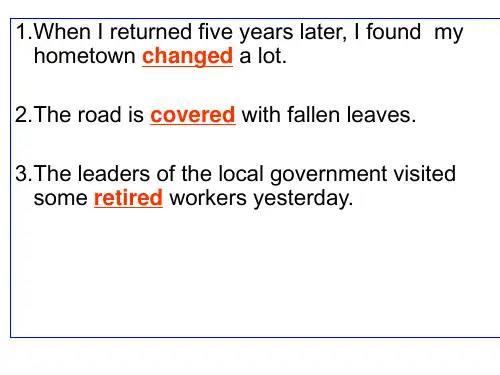
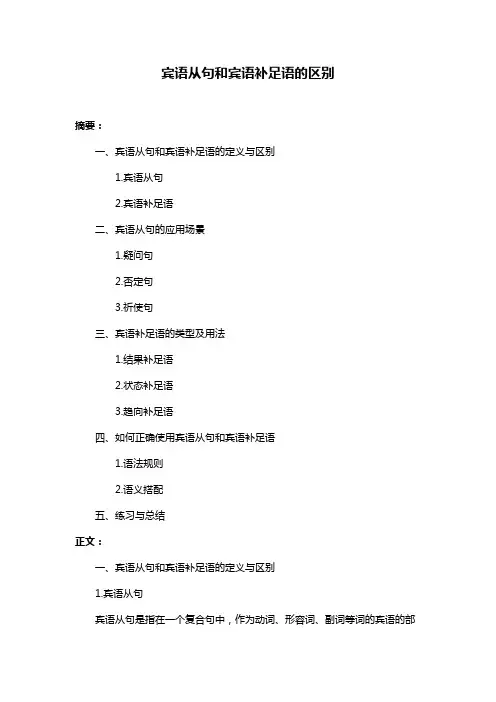
宾语从句和宾语补足语的区别摘要:一、宾语从句和宾语补足语的定义与区别1.宾语从句2.宾语补足语二、宾语从句的应用场景1.疑问句2.否定句3.祈使句三、宾语补足语的类型及用法1.结果补足语2.状态补足语3.趋向补足语四、如何正确使用宾语从句和宾语补足语1.语法规则2.语义搭配五、练习与总结正文:一、宾语从句和宾语补足语的定义与区别1.宾语从句宾语从句是指在一个复合句中,作为动词、形容词、副词等词的宾语的部分,通常由连词、疑问词等引导。
它与主句中的主语、谓语等成分相对应,起到补充说明的作用。
如:- I don"t know what he said.(我不知道他说了什么。
)2.宾语补足语宾语补足语是指在复合句中,动词的宾语部分补充说明宾语的状态、结果或趋向等语义信息。
它通常由介词、副词等引导。
如:- He looked the book up and down.(他翻阅了这本书。
)二、宾语从句的应用场景1.疑问句在疑问句中,通常用宾语从句来提问。
如:- What did he say?(他说了什么?)2.否定句在否定句中,宾语从句用来表示否定的对象。
如:- I didn"t buy anything.(我没有买任何东西。
)3.祈使句在祈使句中,宾语从句用来表示命令或请求的对象。
如:- Bring me the dictionary.(把字典给我带来。
)三、宾语补足语的类型及用法1.结果补足语结果补足语表示宾语所处的状态或结果。
如:- He made the cake rise.(他使蛋糕发酵。
)2.状态补足语状态补足语表示宾语的状态。
如:- She left the room quietly.(她安静地离开了房间。
)3.趋向补足语趋向补足语表示宾语的动作方向。
如:- He put the letter on the table.(他把信放在桌子上。
)四、如何正确使用宾语从句和宾语补足语1.语法规则在使用宾语从句和宾语补足语时,需要注意以下语法规则:- 宾语从句的引导词:连词(如that、whether等)、疑问词(如what、who等)。
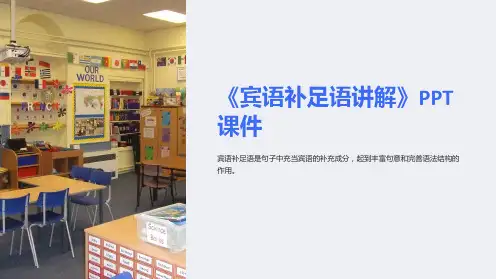
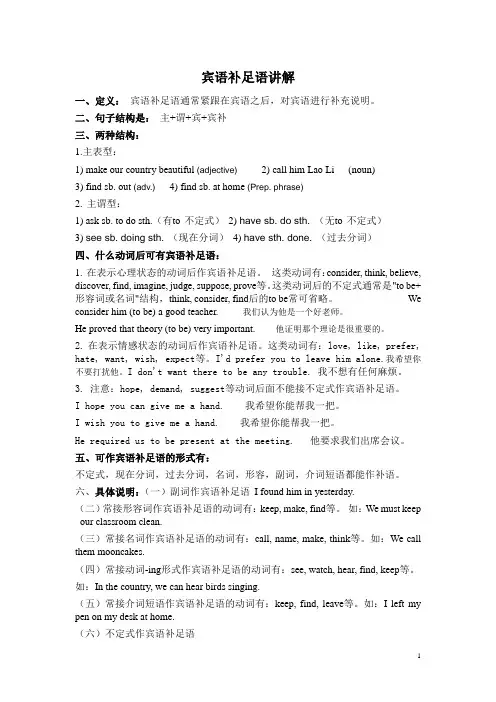
宾语补足语讲解一、定义:宾语补足语通常紧跟在宾语之后,对宾语进行补充说明。
二、句子结构是:主+谓+宾+宾补三、两种结构:1.主表型:1) make our country beautiful (adjective)2) call him Lao Li (noun)3) find sb. out (adv.)4) find sb. at home (Prep. phrase)2. 主谓型:1) ask sb. to do sth.(有to 不定式)2) have sb. do sth. (无to 不定式)3) see sb. doing sth. (现在分词)4) have sth. done. (过去分词)四、什么动词后可有宾语补足语:1. 在表示心理状态的动词后作宾语补足语。
这类动词有:consider, think, believe, discover, find, imagine, judge, suppose, prove等。
这类动词后的不定式通常是"to be+形容词或名词"结构,think, consider, find后的to be常可省略。
We consider him (to be) a good teacher.我们认为他是一个好老师。
He proved that theory (to be) very important.他证明那个理论是很重要的。
2.在表示情感状态的动词后作宾语补足语。
这类动词有:love, like, prefer, hate, want, wish, expect等。
I'd prefer you to leave him alone.我希望你不要打扰他。
I don't want there to be any trouble. 我不想有任何麻烦。
3. 注意:hope, demand, suggest等动词后面不能接不定式作宾语补足语。
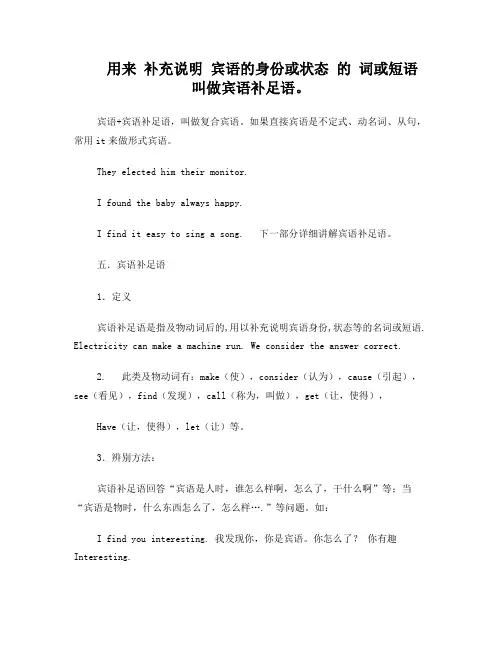
用来补充说明宾语的身份或状态的词或短语叫做宾语补足语。
宾语+宾语补足语,叫做复合宾语。
如果直接宾语是不定式、动名词、从句,常用it来做形式宾语。
They elected him their monitor.I found the baby always happy.I find it easy to sing a song. 下一部分详细讲解宾语补足语。
五.宾语补足语1.定义宾语补足语是指及物动词后的,用以补充说明宾语身份,状态等的名词或短语. Electricity can make a machine run. We consider the answer correct.2. 此类及物动词有:make(使),consider(认为),cause(引起),see(看见),find(发现),call(称为,叫做),get(让,使得),Have(让,使得),let(让)等。
3.辨别方法:宾语补足语回答“宾语是人时,谁怎么样啊,怎么了,干什么啊”等;当“宾语是物时,什么东西怎么了,怎么样….”等问题。
如:I find you interesting. 我发现你,你是宾语。
你怎么了?你有趣Interesting.I saw a book interesting. 我看见一本书,书是宾语。
书怎么样?interesting.4.宾语补足语的构成(1) 名词(包括名词性物主代词):Her father named her Kate.(2) 形容词或形容词短语:They pained their house white.(3) 不定式及其短语:You musn’t force him to lend his money to you.Make, see, have, let, watch, notice, hear, observe等动词后的宾语补足语是不定式时,不加to; help 后的宾补可带也可不带to。

宾语补足语(O b j e c t c o m p l e m e n t)用法归纳概念:英语中含有某些意义的动词跟了宾语后句子仍不完整,还须要一个补足成分,这种补足成分叫做宾语补足语。
宾语补足语是句子的主要成分,这样的句型为:主语+谓语动词+宾语+宾语补足语。
由名词、形容词、副词、介词短语充当宾语补足语,用以说明宾语的类属、性质、状态等意义;由非谓语动词即不定式、现在分词、过去分词充当宾语补足语,用以说明宾语的动作。
①当感官动词和使役动词,如:see hear notice watch hear observe, listen to, feel(感官动词)make have let get(使役动词)接宾补时,不定式的符号to必须省略。
但在被动语态中,动词后要加to。
主动语态:The policeman made him tell everything.被动语态:He was made to tell everything by the policeman.②感官动词see, hear, watch, notice, observe后面的宾语补足语既可跟不带to的动词不定式,也可跟现在分词,其区别在于前者表示“经常性的,习惯性的动作”,后者表示“正在发生的瞬间动作”。
I often hear her sing English songs in the room.Suddenly, Zhang Hua heard someone shouting “Fire! Fire!”③在help后,不定式可以带to,也可不带。
Lucy often helps her brother (to) learn English.④有些动词只能用现在分词作宾语补足语,如:keep, mind, prevent, stop。
动词find, catch等的宾语可由现在分词作宾语补足语。
She caught her son smoking a cigarette.We’d better keep the fire burning.I don’t mind you joking. I like it.The heavy rain prevented us coming here on time.I found him drinking my whisky.⑤hope, demand, suggest等动词后面不能接不定式作宾语补足语。
过去分词作宾语补足语讲解过去分词作宾语补足语是英语语法中的一个重要概念。
在英语语法中,书写和语音是两个不同的事情,因此,有时候我们需要通过语法规则来理解一个句子的意思。
过去分词作宾语补足语的语法规则比较复杂,需要掌握一些基本概念和规则才能够正确地理解和使用它。
一、过去分词的概念二、宾语补足语的概念宾语补足语是指在一个句子中作为宾语的形容词、名词、介词短语或副词短语。
宾语补足语用来说明或补充宾语的意义,通常跟在要求宾语补足语的动词之后。
过去分词作宾语补足语的结构一般是由一个动词和一个过去分词组成。
例如:1. I found the door locked.2. She heard the news reported on the radio.在第一句话中,过去分词“locked”作为宾语补足语,修饰door这个名词。
在第二句话中,过去分词“reported”作为宾语补足语,说明news这个宾语的性质和来源。
1. 表示被动语态例如:“The door was locked”中,“locked”作为过去分词作为被动语态的一部分出现。
2. 表示完成的动作或事实3. 表示受到影响或被改变例如:“The weather has left the grass burnt”中,“burnt”作为过去分词表示草受到了天气的影响而变成了焦黑色的。
4. 表示被描述或评价的性质例如:“I found the soup tasted awful”中,“awful”作为过去分词作为宾语补足语表示这个汤味道很糟糕。
五、注意点过去分词作宾语补足语时,如果它所修饰的宾语有一定的主动性,那么句子的意思会与过去分词意思相反。
例如:“I found the door locked”中door是有被动性的,但是如果改成“I locked the door”就不能用过去分词作宾语补足语了。
总之,理解过去分词作宾语补足语的规则和应用对于学英语的人来说是十分重要的,在掌握这个知识点之后,可以更好地理解英语语法的基本结构和规则。
宾语补足语宾语补足语是用于增补说明宾语的成分。
宾语补足语经常放在宾语以后,和宾语一同组成复合宾语。
一、常有的能接宾语补足语的词语1.使役动词(1)使役动词 makemake 用作使役动词表示“使”时,可跟复合构造,即“ make 宾+语 +宾语补足语”,此中的宾语补足语能够是形容词、名词、不带 to 的不定式、过去分词。
The heavy rain made it impossible for us to go out.大雨使得我们没法出去。
He couldn ’ t make himself heard above the noise of the traffic在交.通喧闹声中他没法使自己让他人听到。
What makes the grass grow?什么使得草生长?★动词不定式作 make 的宾语补足语时要用省略 to 的形式,但假如用在被动语态中, to 必定不可以省略。
She was made to work twelve hours a day她.被迫每日工作十二个小时。
(2)使役动词 havehave 表示“使得 ,, ”,后来接宾语补足语,常用于以下构造:①have sb. do sth.使/ 让某人做某事②have sb. Doing sth.使/ 让某人向来做某事③have sth. Done 使/ 让某事被做;遭受某种不幸The teacher had the little boy write on the blackboard.老师让这个小男孩在黑板上写。
don’ t have the lights burning all the night.不要让灯彻夜亮着。
He had the bike repaired yesterday.昨天他让人修了自行车。
He had his leg broken in the match.在竞赛中他摔断了腿。
(3)使役动词 leaveleave 用作使役动词,表示“使/ 让,, 保持某种状态”,能够用形容词、名词、介词短语、分词作宾语补足语。
宾语补足语(Object complement)用法归纳
概念:英语中含有某些意义的动词跟了宾语后句子仍不完整,还须要一个补足成分,这种补足成分叫做宾语补足语。
宾语补足语是句子的主要成分,这样的句型为:主语+谓语动词+宾语+宾语补足语。
由名词、形容词、副词、介词短语充当宾语补足语,用以说明宾语的类属、性质、状态等意义;由非谓语动词即不定式、现在分词、过去分词充当宾语补足语,用以说明宾语的动作。
①当感官动词和使役动词,如:see hear notice watch hear observe, listen to, feel(感官动词)make have let get(使役动词)接宾补时,不定式的符号to必须省略。
但在被动语态中,动词后要加to。
主动语态:The policeman made him tell everything.
被动语态:He was made to tell everything by the policeman.
②感官动词see, hear, watch, notice, observe后面的宾语补足语既可跟不带to的动词不定式,也可跟现在分词,其区别在于前者表示“经常性的,习惯性的动作”,后者表示“正在发生的瞬间动作”。
I often hear her sing English songs in the room.
Suddenly, Zhang Hua heard someone shouting “Fire! Fire!”
③在help后,不定式可以带to,也可不带。
Lucy often helps her brother (to) learn English.
④有些动词只能用现在分词作宾语补足语,如:keep, mind, prevent, stop。
动词find, catch等的宾语可由现在分词作宾语补足语。
She caught her son smoking a cigarette.
We’d be tter keep the fire burning.
I don’t mind you joking. I like it.
The heavy rain prevented us coming here on time.
I found him drinking my whisky.
⑤hope, demand, suggest等动词后面不能接不定式作宾语补足语。
错误:I hope you to come here tomorrow.
正确:I hope you can come here tomorrow.
⑥表示心理状态的动词consider, think, believe, discover, find, imagine, judge, suppose, prove等动词后的不定式通常是“to be+形容词或名词”结构,to be常可省略。
We consider him (to be) a good teacher.
He proved that theory (to be) very important.
I thought her (to be) nice and honest the first time I met her.
⑦当宾语是不定式、动名词或宾语从句时,往往把宾语放在它的补足语后,而用it作句子的形式宾语,放在宾语补足语之前,将真正的宾语置于补足语之后。
如:
I think it wrong to smoke in public.
I find it hard to learn English well.
She kept it secret that she hadn’t passed the exam.
I think it important that we should keep calm.。